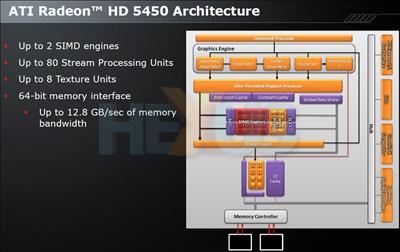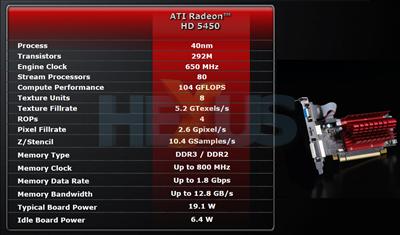The special sauce
The architecture
AMD's modular 5-series GPU architecture can be traced back to the full-fat Radeon HD 5870 that was released in September last year. AMD ploughed the high end of the market first, gaining margin, albeit with severe supply restrictions for the remainder of 2009, and then augmented them with the HD 5750/70 and HD 5670 products.Each successive derivation has removed parts of the 5K architecture in order to reduce die-size and therefore help decrease the GPU cost. Helped on by the need for fewer on-PCB components and lower-speed memory, AMD's been able to play the segmentation game pretty well thus far...well before NVIDIA brings its own next-gen. architecture to bear.
But designing for margin in a sub-$50 card has historically translated to a significant sacrifice in the facets of the card - shaders, ROPs, memory-bandwidth, etc. - that make up performance. Cutting to the chase, here's the Radeon HD 5450's block diagram:
The best method of explaining the architecture differences and conjecturing upon subsequent impact on performance is to lay out the single-GPU R5K cards out in a table.
How to make it really cheap?
| GPU | Process | Transistors | Stream Processors | Texture
units |
ROPs |
Memory
width (bits) |
Memory type | Max board power (watts) | Idle board power (watts) | Etail price (US dollars) |
|---|---|---|---|---|---|---|---|---|---|---|
| Radeon HD 5870 | 40nm | 2,080m | 1,600 | 80 | 32 | 256 | GDDR5 | 188 | 27 | 399 |
| Radeon HD 5770 | 40nm | 1,040m | 800 |
40 | 16 | 128 | GDDR5 | 108 | 18 | 165 |
| Radeon HD 5670 | 40nm | 627m |
400 | 20 | 8 | 128 | GDDR5 | 61 | 14 | 95 |
| Radeon HD 5570 |
? | ? | ? | ? | ? | ? | ? | ? | ? | ? |
| Radeon HD 5450 |
40nm |
292m |
80 |
8 |
4 | 64 |
DDR2/DDR3 |
19.1 |
6.4 |
49-59 |
At the moment, the next class of GPU is the $99 Radeon HD 5670. What's clear is that AMD's really pared the architecture to ensure that the HD 5450 hits the proposed price point.
The stream processors are down from 400 to 80 (five SIMD engines to two); texture units see a similar percentage snip; render back-ends aren't quite as badly affected, but memory-bandwidth is reduced by a narrower bus - 64 bit vs. 128 - and the use of cheaper memory that runs at a lower speed.
The bottom line is that the HD 5450 will be significantly slower than the HD 5670 - to the tune of running at one-third the performance, going by the numbers we're looking at. AMD will complete the DX11 line-up with the HD 5570 that should bridge the gap between the two aforementioned GPUs.
An upshot of this downsizing is a GPU that packs in 292m transistors and is therefore (relatively) cheap to produce on a high-yield 40nm process. We'll evaluate whether AMD has chopped off too much in our look at the card's performance.











